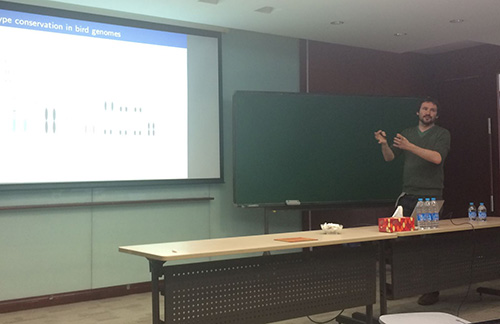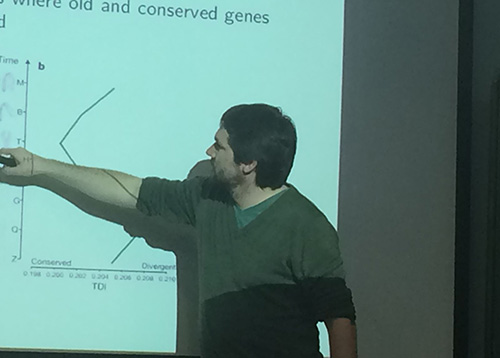Time: 2:00 p.m.,Friday, Nov. 6, 2015
Venue: Room 2201, East Guanghua Building, Handan Campus, Fudan University
Speaker: Toni I. Gossmann
University of Sheffield (UK)
http://toni-gossmann.staff.shef.ac.uk/
t.gossmann@sheffield.ac.uk
Title: Aspects of genome evolution in birds and plants
Abstract:
There are two recent research projects
(1) Reconstructing a fine scale recombination rate map of the great tit genome and its implication in genome evolution
A special feature of birds is the very high karyotype conservation – bird genomes usually consists of around a dozen large macrochromosomes and numerous tiny microchromosomes. This heterogeneity in chromosome size causes a substantial variation in recombination rate between chromosomes. There is also known variation within macrochromosomes. Nonetheless, despite the stable karyotype, intrachromosomal rearrangements were common during avian genome evolution. However, it is unclear how this affected the long-term recombination environment in bird genomes.
Unlike other commonly studied bird species, the great tit (Parus major) has a large, panmictic population, making it an ideal system to study genome-wide patterns of recombination rate variation and its effects on patterns of polymorphism and divergence. So far, little focus has been given on fine-scale recombination variation in the avian lineage and therefore we use resequencing data from 29 great tit individuals to reconstruct a fine scale recombination map. We scan the genome for traces of positive and purifying selection in protein coding genes to illustrate how recombination has facilitated the action of natural selection due to Hill-Robertson-Interference. In sum, this study reveals the fundamental role of recombination and its impacts on the composition of genomes.
(2) Plant reproductive development is characterised by a transcriptomic evolutionary bulge
The evolutionary patterns associated with plant reproduction on a genome wide scale are currently poorly investigated. Recently it was shown for Arabidopsis thaliana that during embryogenesis ancient and conserved genes disproportionally contribute to the overall transcriptome. This resembles an evolutionary hourglass – a concept originally derived from the common morphology during animal embryogenesis. However, it is unclear whether the hourglass model is a general phenomenon during plant development and how this pattern compares to developmental stages preceding fertilization, such as during gametogenesis.
We investigate this question using whole-genome tissue specific transcriptomic data from three plant species, A. thaliana and rice (Oryza sativa) and soybean (Glycine max). As a remarkable pattern we observe in all three species that during plant gametogenesis a shift in gene expression is observed where young and less conserved genes predominantly contribute to the transcriptome. We refer to this phenomenon as an evolutionary bulge during plant reproductive development. Our findings suggest that genes expressed during plant gamete development are on average younger, are rapidly evolving and that they currently experience less evolutionary constraint than genes expressed during other developmental stages. In contrast, we find little evidence for a transcriptomic hourglass as a general pattern during plant embryogenesis.



